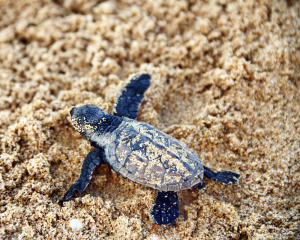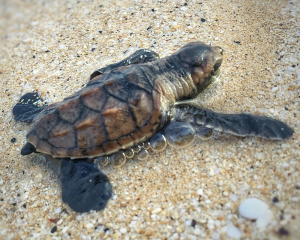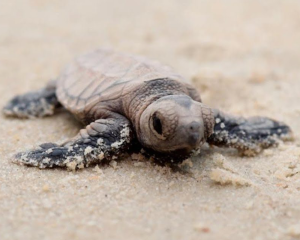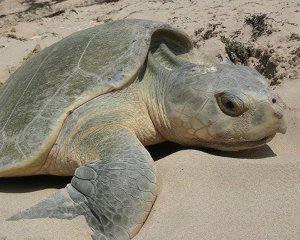
The hawksbill turtle (Eretmochelys imbricata) is a critically endangered sea turtle species known for its distinctive shell and important role in marine ecosystems. It is one of the seven species of sea turtles and is found in tropical and subtropical oceans around the world. Here are some detailed characteristics and information about the hawksbill turtle:

Physical Characteristics
Size: Hawksbill turtles are medium-sized sea turtles. Adult hawksbills typically measure between 60 to 95 centimeters (24 to 37 inches) in carapace length and weigh between 45 to 70 kilograms (100 to 154 pounds). The largest individuals can reach up to 114 centimeters (45 inches) in length and weigh up to 90 kilograms (200 pounds).
Appearance: They are known for their beautiful, colorful shells, which have overlapping scales, or scutes, giving them a serrated appearance along the edge. The carapace features a pattern of amber, brown, and yellow colors, often arranged in a tortoiseshell pattern. This distinctive shell has historically made them a target for the tortoiseshell trade.
Head and Beak: Hawksbill turtles have a narrow, pointed head with a bird-like beak, which gives them their common name. The shape of their beak is well adapted for reaching into crevices of coral reefs to feed on sponges and other invertebrates.

Behavior
Habitat: Hawksbill turtles are primarily found in coral reef habitats, where they spend most of their adult life. They are also found in rocky areas, lagoons, and mangrove swamps. Juvenile hawksbills are more pelagic and can be found in open ocean environments before settling into coastal areas as they mature.
Diet: Hawksbill turtles are omnivorous but have a diet that is highly specialized towards sponges, making up a significant portion of their diet. They also consume other marine invertebrates, such as jellyfish, sea anemones, and algae. Their feeding habits help maintain the health of coral reefs by controlling sponge populations that might otherwise overwhelm the coral.
Reproduction: Female hawksbill turtles return to the beaches where they were born to lay their eggs. Nesting occurs every two to four years, with each female laying multiple clutches of eggs during a nesting season, each containing 100 to 200 eggs. The eggs incubate for about 60 days before hatching, and hatchlings emerge and make their way to the ocean.

Conservation Status
Population: The hawksbill turtle is critically endangered, with populations having declined by more than 80% over the past century. There are an estimated 8,000 nesting females left worldwide, with significant populations in the Caribbean, Southeast Asia, and the Western Pacific.
Threats: The primary threats to hawksbill turtles include illegal hunting for their shells, which are used to make jewelry and other decorative items. Habitat loss due to coastal development, climate change, and coral reef degradation also poses significant risks. Additionally, hawksbills are threatened by accidental capture in fishing gear (bycatch), pollution, and the consumption of their eggs by humans and other animals.
Conservation Efforts: Conservation efforts for hawksbill turtles focus on protecting nesting beaches, regulating and enforcing bans on the international trade of tortoiseshell, and establishing marine protected areas to safeguard critical habitats. Conservation organizations also work to reduce bycatch through the use of turtle-friendly fishing gear and to restore degraded coral reefs, which are essential habitats for hawksbill turtles.

Importance
Hawksbill turtles play a crucial role in marine ecosystems, particularly in maintaining the health of coral reefs. By feeding on sponges, they help to control sponge populations, which in turn allows for greater coral growth and the overall diversity of reef ecosystems. The protection of hawksbill turtles is essential not only for the survival of the species but also for the health and stability of coral reef habitats, which support a vast array of marine life. Saving the hawksbill turtle is critical for maintaining biodiversity and ecological balance in tropical marine environments.



